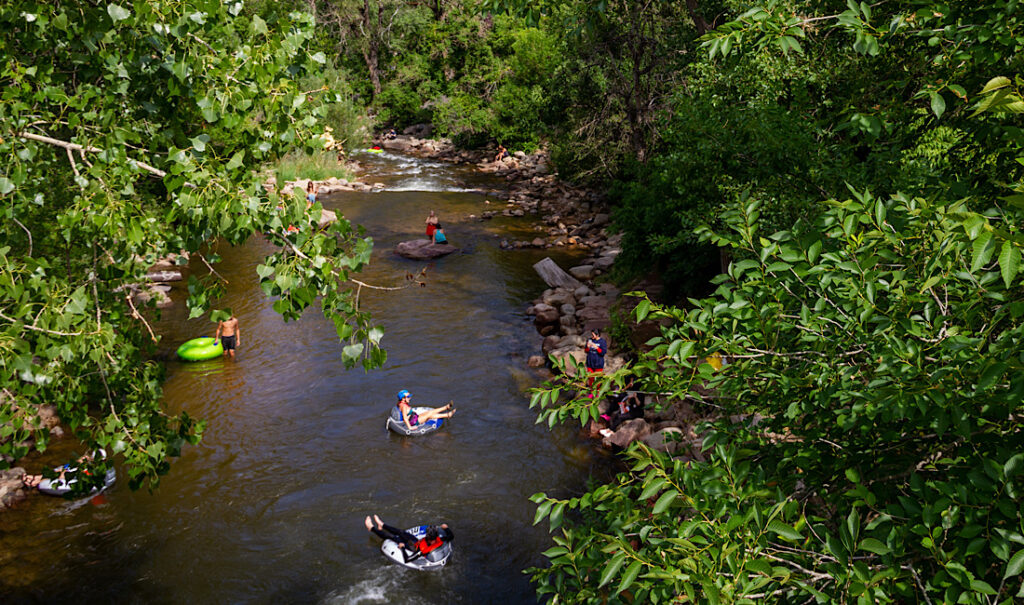
As Vail’s lush summer greens begin to fade into the golden hues of early fall, the window for one of the town’s most beloved warm-weather pastimes—tubing down Gore Creek—starts to close. Tubing season in Vail doesn’t last forever, and if you’ve been waiting for the perfect moment to plan your float, that moment is now. Whether you’re a local squeezing in one more ride or a visitor hoping to experience the town like a longtime resident, understanding the end-of-season timing and knowing how to prepare makes all the difference. Here’s your guide to catching the final float before tubing season officially winds down.
When Tubing Season Winds Down in Vail
Gore Creek is fed by snowmelt from the Gore Range, which means its water levels depend entirely on natural runoff, rainfall, and temperature. As summer begins to shift into fall, Vail’s cooler nights and drier days gradually reduce the volume and flow of the creek. While tubing season usually hits its peak between July and August, the final weeks to float typically fall between mid-August and early September, depending on the year’s weather.
During the later part of the season, the creek’s flow often drops below 100 cubic feet per second (cfs), which can make floating slower and more shallow—sometimes enjoyable for short stretches, but no longer viable for longer routes or group tubing. Tubing is best for kids when flows drop below 100 CFS
If you’re considering a late-season tubing trip:
- Check water levels frequently. Locals rely on real-time flow data to determine if a float is worth it.
- Aim for midday floats. The warmest part of the day offers the most comfortable conditions as nights get cooler.
- Know your routes. Shallow areas may require walking, so shorter sections like Ford Park to Lionshead become the most reliable.
Vail’s tubing scene isn’t supported by year-round outfitters in the same way rafting or kayaking might be, so this time of year brings a natural wind-down to informal gear rentals and available services. That makes early planning essential, especially if you’re counting on family-friendly routes or need new gear to make the trip comfortable.
Why Late-Season Tubing Is a One-of-a-Kind Experience
While many associate river tubing with the height of summer, there’s something special about catching the last few floats of the season. Locals often refer to this time as the hidden gem of the tubing calendar. Here’s what sets it apart from peak-season rides:
Fewer Crowds, More Tranquility
By late August, summer tourism begins to ease, especially midweek. That means fewer people on the water, easier parking, and a calmer environment where the creek feels like your own private trail. It’s ideal for those looking to avoid the bustle of high-season activity.
Scenic Shifts Toward Autumn
One of the biggest perks of late-season tubing is witnessing the first signs of fall. Golden aspen leaves start to shimmer along the banks, and the light begins to soften into that rich, end-of-summer glow. Tubing at this time offers some of the most photogenic scenes of the entire year.
Wildlife Sightings Increase
With fewer floaters on the water and quieter surroundings, wildlife becomes more visible. You may spot deer near the tree lines, hear more bird calls, or even catch glimpses of foxes or marmots in the early hours of the day.
Gentle Currents for Easy Floating
Lower water levels mean a slower, more relaxed pace—perfect for families with younger children or anyone who just wants to enjoy a calm cruise. It’s less about thrill and more about taking in the natural beauty and fresh air before cooler temperatures arrive.
Ideal Lighting for Late-Day Floats
The position of the sun in early September gives Gore Creek an entirely new look. Floating between 3:00 and 5:30 PM offers warm, golden lighting that locals love for photography or just basking in the natural beauty. It’s also a great time to wrap up with a sunset dinner or drink nearby.
These subtle but memorable elements make late-season tubing feel like a well-kept secret, often overlooked by those who assume the season ends as school starts. For those in the know, it’s the best way to transition from summer to fall—peaceful, scenic, and restorative.
How to Plan the Perfect Last Float
As tubing season nears its close, a little extra planning ensures your final trip is as safe and enjoyable as possible. Since many seasonal weather changes happen quickly in mountain towns, locals recommend checking conditions the day before your float and being prepared for anything from chilly water to early evening winds.
Tips for a Successful Late-Season Float:
- Pick the right section of the River–The upper Colorado has a section of the River which can be floated until mid-September (Rancho To State Bridge, State Bridge to Two Bridges)
- Pack extra layers or towels—even on sunny days, post-float temps can cool quickly.
- Bring sturdy tubes designed for rocky conditions, as lower water levels expose more creekbed.
- Wear closed-toe water shoes and consider gloves if the air feels brisk.
- Pay attention to the flows and the weather–avoid rain or windy days.
You’ll also want to make post-float plans that include warm-up options like coffee shops, patio heaters, or nearby casual dining—especially important if you’re tubing with kids or visitors not used to the alpine climate.
With fewer people on the water in late summer, now is also the time to enjoy a more peaceful float. The creek quiets down, wildlife sightings increase, and the surrounding foliage begins its transformation into fall colors—offering one last, scenic look at summer’s retreat.
Make your final Gore Creek tubing adventure the best one yet! Call 970-476-1477 for local advice, reliable gear, and insider tips to plan a safe, scenic, and stress-free late-season float. Let us help you soak up every last bit of Vail’s summer magic before the season ends!
